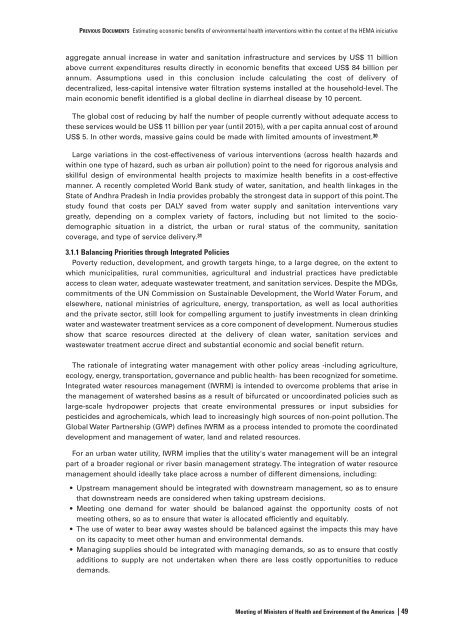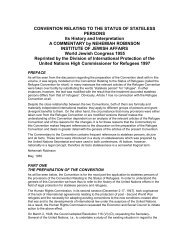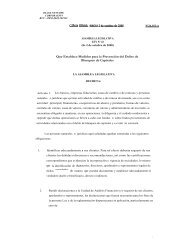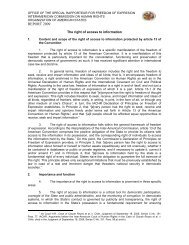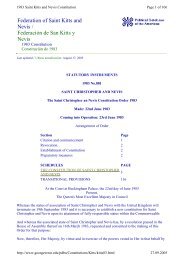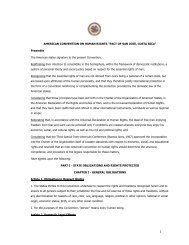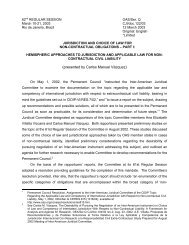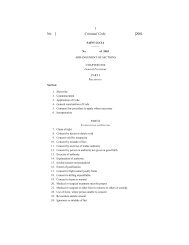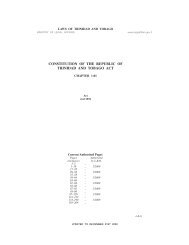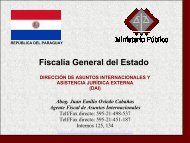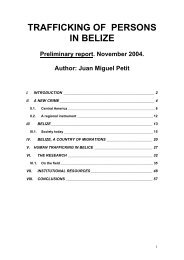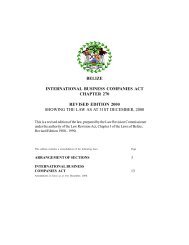(HEMA) Initiative. - OAS
(HEMA) Initiative. - OAS
(HEMA) Initiative. - OAS
You also want an ePaper? Increase the reach of your titles
YUMPU automatically turns print PDFs into web optimized ePapers that Google loves.
PREVIOUS DOCUMENTS Estimating economic benefits of environmental health interventions within the context of the <strong>HEMA</strong> iniciative<br />
aggregate annual increase in water and sanitation infrastructure and services by US$ 11 billion<br />
above current expenditures results directly in economic benefits that exceed US$ 84 billion per<br />
annum. Assumptions used in this conclusion include calculating the cost of delivery of<br />
decentralized, less-capital intensive water filtration systems installed at the household-level. The<br />
main economic benefit identified is a global decline in diarrheal disease by 10 percent.<br />
The global cost of reducing by half the number of people currently without adequate access to<br />
these services would be US$ 11 billion per year (until 2015), with a per capita annual cost of around<br />
US$ 5. In other words, massive gains could be made with limited amounts of investment. 30<br />
Large variations in the cost-effectiveness of various interventions (across health hazards and<br />
within one type of hazard, such as urban air pollution) point to the need for rigorous analysis and<br />
skillful design of environmental health projects to maximize health benefits in a cost-effective<br />
manner. A recently completed World Bank study of water, sanitation, and health linkages in the<br />
State of Andhra Pradesh in India provides probably the strongest data in support of this point. The<br />
study found that costs per DALY saved from water supply and sanitation interventions vary<br />
greatly, depending on a complex variety of factors, including but not limited to the sociodemographic<br />
situation in a district, the urban or rural status of the community, sanitation<br />
coverage, and type of service delivery. 31<br />
3.1.1 Balancing Priorities through Integrated Policies<br />
Poverty reduction, development, and growth targets hinge, to a large degree, on the extent to<br />
which municipalities, rural communities, agricultural and industrial practices have predictable<br />
access to clean water, adequate wastewater treatment, and sanitation services. Despite the MDGs,<br />
commitments of the UN Commission on Sustainable Development, the World Water Forum, and<br />
elsewhere, national ministries of agriculture, energy, transportation, as well as local authorities<br />
and the private sector, still look for compelling argument to justify investments in clean drinking<br />
water and wastewater treatment services as a core component of development. Numerous studies<br />
show that scarce resources directed at the delivery of clean water, sanitation services and<br />
wastewater treatment accrue direct and substantial economic and social benefit return.<br />
The rationale of integrating water management with other policy areas -including agriculture,<br />
ecology, energy, transportation, governance and public health- has been recognized for sometime.<br />
Integrated water resources management (IWRM) is intended to overcome problems that arise in<br />
the management of watershed basins as a result of bifurcated or uncoordinated policies such as<br />
large-scale hydropower projects that create environmental pressures or input subsidies for<br />
pesticides and agrochemicals, which lead to increasingly high sources of non-point pollution. The<br />
Global Water Partnership (GWP) defines IWRM as a process intended to promote the coordinated<br />
development and management of water, land and related resources.<br />
For an urban water utility, IWRM implies that the utility's water management will be an integral<br />
part of a broader regional or river basin management strategy. The integration of water resource<br />
management should ideally take place across a number of different dimensions, including:<br />
• Upstream management should be integrated with downstream management, so as to ensure<br />
that downstream needs are considered when taking upstream decisions.<br />
• Meeting one demand for water should be balanced against the opportunity costs of not<br />
meeting others, so as to ensure that water is allocated efficiently and equitably.<br />
• The use of water to bear away wastes should be balanced against the impacts this may have<br />
on its capacity to meet other human and environmental demands.<br />
• Managing supplies should be integrated with managing demands, so as to ensure that costly<br />
additions to supply are not undertaken when there are less costly opportunities to reduce<br />
demands.<br />
Meeting of Ministers of Health and Environment of the Americas | 49


